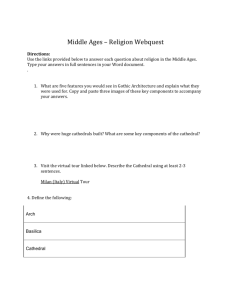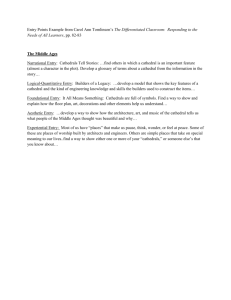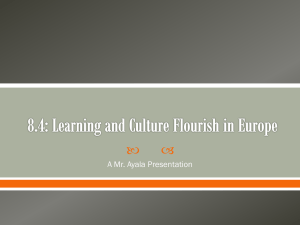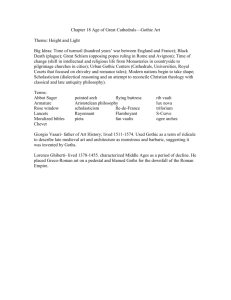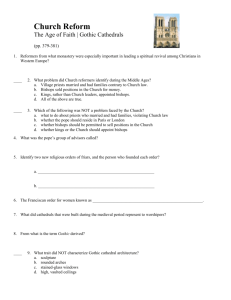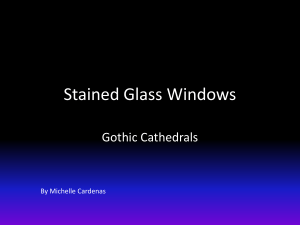Gothic Cathedrals
advertisement
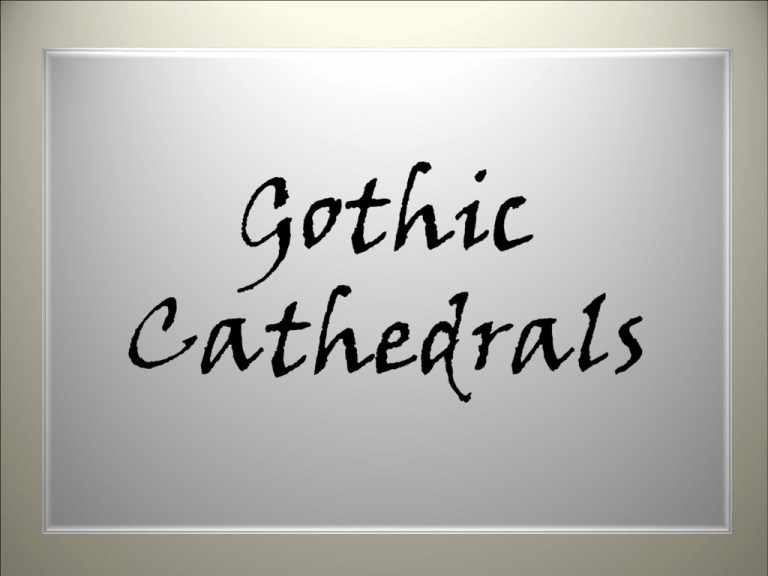
Gothic Cathedrals What do you imagine when you hear the word ‘GOTHIC’ used? or You may be surprised to learn that by the middle of the 20th century a new style of Church – later labelled “GOTHIC” began to appear across Europe, starting in France. And it wasn’t dark and gloomy but rather, it was filled with LIGHT Some of the greatest achievements of the late Middle Ages are the Gothic cathedrals. These magnificent buildings were designed and built by people of GREAT FAITH. They wanted to give HONOUR and GLORY to TE ATUA through their arts and crafts. At this time, the majority of people were illiterate, so the Gothic cathedrals and churches became a kind of Bible that revealed a spiritual world to the educated and uneducated alike. How did they do this? Gothic cathedrals have two identifying qualities; HEIGHT LIGHT HEIGHT The Cathedral of Our Lady of Chartres (France) Reims Cathedral (France) The intention of the soaring Gothic cathedral was to lead; the eye upward to heaven and the soul away from the things of earth The tall and pointed spires created an impression that the cathedrals were reaching up to God in heaven. How did they achieve such great height? FLYING BUTTRESSES Notre Dame Cathedral, France • Flying Buttresses were external supports. • They allowed the architects to build walls that were much thinner and higher. • These walls were now freed from bearing the weight of the ceiling so they could be designed with large openings. Artists filled these with stained glass – hence creating more....... LIGHT • Stained glass windows were made up of small pieces of coloured glass fitted together to form images that told the stories of Jesus, Mary and the saints. • When the sun shone through these stained glass windows, the light made multi-coloured patterns on the floor. This created a heavenly atmosphere Lancet Window -Chartres Cathedral, France. (a tall thin stained glass window with a pointed top) Rose Window – Notre Dame, France (a circular stained glass window usually constructed above the entry of the church) Other Features of Gothic Cathedrals THE FLOOR PLAN What do you notice about the following floor plan? Chartres Cathedral Floor Plan Did you say the floor plan was in the shape of a cross? • This was a reminder of Jesus’ passion and death. • The Church was the Body of Christ and the physical church building was a reminder of that spiritual reality. How long do you think it took to build a Gothic Cathedral? Most cathedrals took over a CENTURY to build, with several generations becoming part of the project. The building of a cathedral was a community affair and a matter of civic pride. Cities complete with each other to build churches with the tallest towers and spires. • Each church had its wealthy patrons, but ordinary citizens contributed sheep, poultry, cheeses, animal skins and vegetables towards the building of their cathedral. • While the cathedral was under construction an entire village of workman would be established at the site. Many hundreds of cathedrals remain in Europe today – a reminder of a period when the Church was the most powerful authority and the house of God the most important building in the community. Universities & the Spread of Learning Many of the cathedrals had their own schools – mainly to train future priests. But, as the populations of towns and cities increased there was a greater demand for education. Teachers and students at the cathedral schools started grouping together to study a wider range of subjects – Rhetoric Logic Literature Mathematics Philosophy Theology Medicine Law These groups came to be known as universities. The first European University – Bologna, Italy 1119 The Church encouraged the growth of universities because; they provided the quality education that was necessary for those in key positions within the Church The Church believed that knowledge gained in any field of learning would help people understand and appreciate God’s creation. Printing & Reading The invention and spread of the printing press did more than anything else to improve learning throughout Europe. As pamphlets and books became more readily available, more and more people saw the point in learning to read. Ordinary people wanted to be able to read the Bible for themselves, in their own language. Thomas Aquinas one of the greatest philosophers and teachers of the Middle ages. greatest achievement was to show that human reason when properly used, supported faith. made a saint in 1323. he is the patron saint of all Catholic Universities. Images for this power point presentation were sourced from http://wikipedia.org
